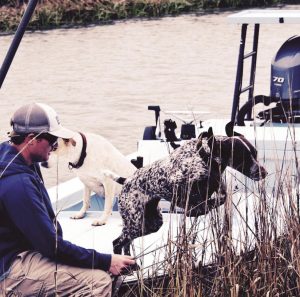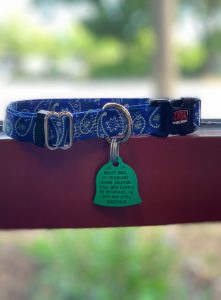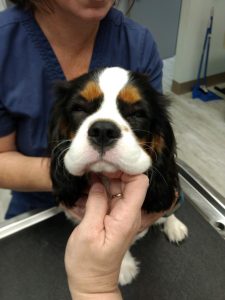As the weather gets warmer, more of us want to spend time outdoors, this can also mean spending more time outside with our pets. While we may want to include our four legged companions in all our plans, here are some things to keep in mind.

Courtesy of Dr. Eppelsheimer’s, Doc Dog Charters
Including your pet on a boating trip can be great fun but remember to provide them with plenty of shade and fresh water.
They are in fur coats all year long! Shade is what dogs crave, not laying out getting a tan, so provide a cool, shady spot while you are sunning, for their comfort. Swimming is fun and refreshing, but they can’t quench their thirst with the salt water any more than you can. Stock up on fresh water and bowls for them, too! While out on or near the water, be careful of oyster beds. Your pup may need to take a bathroom break or see an exciting pile of “shells” to stretch their legs on but oyster shells are razor sharp and can result in painfully sliced paws. Remember, your pets are essentially barefoot out there!
Heat stroke can happen quickly and in surprisingly cooler temps than we think.
Not only can pets get overheated on the beach, but in cars as well. NEVER leave your pet in a car for any length of time. Excessive panting, bright red gums, reluctance to move, loss of consciousness, elevated internal body temperature, recent exposure to exercise or high temps are all signs of concern. Short faced breeds, overweight animals, or the very young or old, pets with diseases like cushings or laryngeal paralysis are most susceptible. A cool, NOT ice cold, shower for your pet is an immediate way to begin treating heat stroke. Make sure the water goes over the top of the neck and back, but do not submerge their head. The temperature needs to be reduced gradually to protect internal body organs trying to recover. Get to an animal clinic as soon as possible if your pet shows any signs of heat stroke!
Picnics and outdoor parties with great food is great fun.. for people, but pets with easy access to the food, need to beware.
There are lots of toxic or dangerous foods that humans enjoy, without a second thought. Chicken wings/bones, rib bones, avocado pits and corn on the cob can be an obstructional hazards, and can become stuck while making its way through the body of your pet. Toxic foods like avocado, chocolate, artificial sweeteners, grapes/raisins, macadamia nuts, garlic, and onions are all no-no’s for your pets! Occasional vomiting and diarrhea can result from the avocado compound persin, but this is far more serious in birds and large animals. Chocolate ingestion most of us have all heard of,(theobromine- dogs metabolize this compound MUCH slower than humans which is what allows it to get to toxic levels) but as a general rule the darker the chocolate the more risk for serious toxicity. For xylitol, check any food label for this artificial sweetener. It can even be found in gum and peanut butter! This toxin can result in an acute drop in blood sugar and develop further into liver failure and may require a trip to the animal hospital. Grapes and raisins if ingested MAY cause an acute kidney failure. These foods are by far the most common ingested toxic foods in dogs. Macadamia nuts can also cause a syndrome of vomiting, diarrhea, weakness, and fever. Pancreatitis from this high fat nut can also ensue. Cats usually hit garlic and onions. this can cause a breakdown of the red blood cells.
Be mindful of leash laws, rabies tag laws, and beach etiquette in general.
Unleashed dogs can carry a hefty fine. Visit the town’s website to scope out the rules before hitting the beach. It is also important to remember that your healthy dog isn’t the only dog out and about. While that cute puppy over there may LOOK healthy, there are illnesses that can be picked up in a number of places and ways. Air borne illness, as well as transmission from sniffing or licking areas of infected pets, can be a source of disease transmission. Always keep your pet’s vaccines current, and check with your vet for any emerging diseases in your area, and update if necessary. Summer is also when wild animals are out and about breeding. Be mindful of these creatures and allow them their space. Raccoons and rats can carry a bacterial disease contagious to animals and people. Leptospirosis is preventable in dogs with the leptospirosis vaccine.
Ticks and fleas are always fair game here in the south, and we know they carry numerous diseases. Keep them protected from infestations with appropriate preventions.
Venomous bites or stings
Be on the lookout for stinging insects! Have Benadryl ready, until you can be seen by your veterinarian. Facial swelling is the most common signs of a sting or snake bites, but either can become serious and may require hospitalization. In dogs, the head and neck areas are the most common sites affected by bites or stings, as dogs are usually sniffing at these creatures before the injury occurs. Cats commonly receive stings or bites to the forelimbs or paws, as cats prefer to bat at something, before sniffing or biting it.










